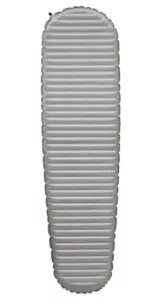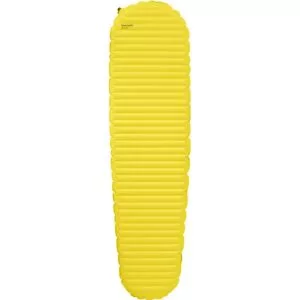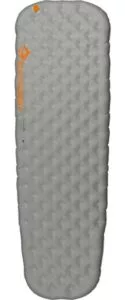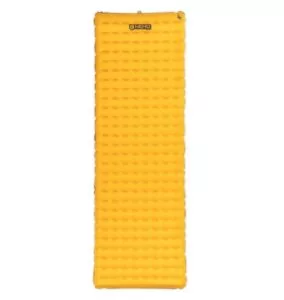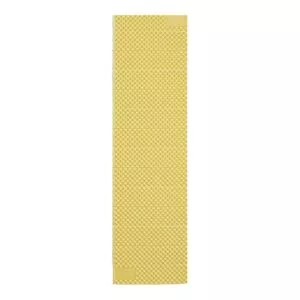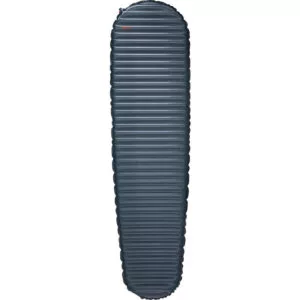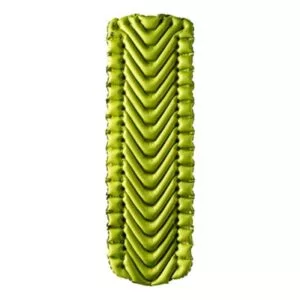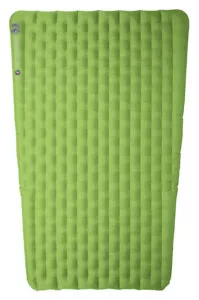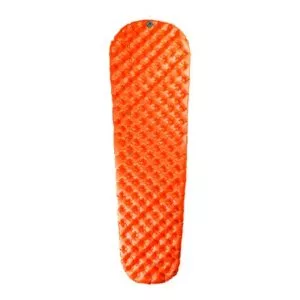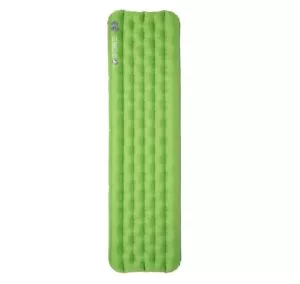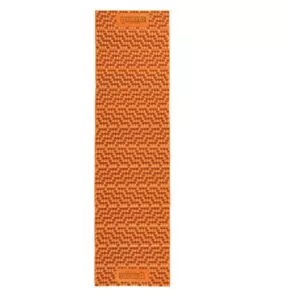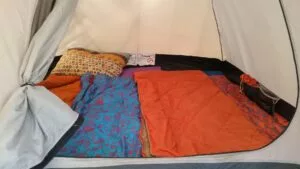
The Best Sleeping Pads in Canada
Whether camping at your favourite campground, or trekking through the trails to reach your campsite, sleep is important. Being able to get a good night’s rest to prepare for more kilometers or to just enjoy your next day will make your entire trip that much more enjoyable. While there are countless ways to sleep outside comfortably, getting a good sleeping pad can be the easiest way.
A sleeping pad may seem very simple to look for, but there’s a lot of different qualities that can make or break your experience with a pad. The style of pad, the way the pad’s cells or cushioning is organized, and the insulation of the pad dictates comfort; the type of materials used, the denier of the fabric, and the type of valve (for inflatable pads) will determine the durability of the pad; the weight and packability define how easy it will be to take on trail. If this seems like a lot to keep track of, this is the article for you.
For more guides for camping gear for your next long-weekend campout or multi-night backpacking journey, check out our camping guides here.
Our top picks
What to look for in a sleeping pad
Intended use – There are expansive choices on the market for sleeping pads or sleep systems when camping. Which type of sleep system will be optimal for you heavily reflects your intended use.
If the extent of your summer plans are car camping in a beautiful locale, there are countless options in terms of sleep systems: You can buy a classic air mattress, a cot, a foam mattress, or even pack a hammock in.
But if you have limited packing space, or weight is a consideration, then your best bet is likely a sleeping pad. Sleeping pads are often inflatable pads that compact right down into a packable size and do not need a pump to be packed out.
You should consider when and where you plan on bringing out your sleeping pad – the climate, the location, the conditions, and the distance you need to travel to your site should help guide your decision.
Comfort – When shopping for any type of mattress, comfort is super important. It can be super hard to determine how comfortable a sleeping pad or air mattress is until you test it out. Unfortunately, this is not always possible, especially when shopping online.
Durability – It’s hard to talk about the durability of products like sleeping pads. While material and construction are important factors that determine the durability, how you treat your sleeping pad will really determine durability. We mentioned issues regarding durability where we noted them, however really and truly, the quality of the materials and how you use the sleeping pad are about equal in determining how
Insulation or R-Value – Having a well-insulated sleeping pad will immensely help you stay warm when the temperature dips at night. A well-insulated sleeping pad keeps your body heat on the pad, preventing losing heat to the cold ground. To find a sleeping pad with the level of insulating property you need, look at the R-value listed on each sleeping pad. R-value is a measure of insulating performance, with the higher the number meaning the better insulating the pad is. An R-value of around 3 or 4 will suffice, being warm enough to be able to withstand temps approaching zero up on the mountain or in three-season use.
Size – How do you sleep? Whether you sleep on your side or back, or whether you sleep with a special someone or solo when camping will help determine whether a sleeping pad of a certain size will suit you. You should have an idea before shopping whether you would want a single or a double sleeping pad.
Weight – Weight is a consideration for all of our camping gear articles, since backpackers in particular care greatly about the amount of weight they can bring with them. Sleeping pads are not as weight intensive as your sleeping bag, your tent or your backpack (the big 3 of backpacking) but getting a good sleeping pad can get the most out of a lightweight sleeping bag and can prevent you bringing more unnecessary weight on the trail.
Packability – Packability refers to the smallest size that a sleeping pad can feasibly pack down to. When doing a multi-day trip, space can really be at a premium. Balancing the size of the sleeping surface versus the packable size might be tricky, but at the end of the day, most of these pads are easily packable.
Price – Price is always a factor in terms of any hobbyist products. Some of the best performing sleeping pads we have covered come close to the $300-400 CAD range, which are absolutely not necessary for entry-level campers or people who stick to the summer months to get their camping in. You can buy strong performing sleeping pads at a fraction of the price, with some caveats in terms of the comfort, durability, or packability of the pad.
The best ultralight pad
Therm-a-rest NeoAir XLite
The point of ultralight gear is not to simply be lightweight, but to give you an overall lighter pack without losing any of the utility. Therm-a-rest has dedicated themselves to making pads that are not only lightweight, but with so much utility that you can save on the weight greatly.
The Therm-a-rest NeoAir XLite comes in 4-sizes (small, regular, large, regular wide). In all four sizes, the NeoAir XLite is both genuinely lightweight and thick (at 6.3 inches) especially when pumped up to capacity. Constructed from horizontal baffles, this pad smoother and more continuous than some of the other types of pads that are on the market. The base version of the XLite is just 20-inches wide, and the large version is 25-inches wide, so consider the latter if you appreciate the wiggle room on a sleeping pad, especially since the edges of this pad are not very well supported.
The Therm-a-rest XLite is air construction pad, which does not include any materials like down or synthetic insulation. Instead, to maintain its R-value of 4.2, the NeoAir XLite uses what they call a “Triangle Core Matrix” design, which consists of a series of triangular baffles that line the inside of the pad and keep warm and cold air away from each other. Combined with a reflective lining to bounce thermal heat towards the sleeper
At 390 grams for the pad alone (or 453 grams when pump sack and stuff sack are included), the regular size pad offers sharp weight savings over most pads. While it is not the lightest mat available, considering the comfort and R-value of this pad, the lightness is quite impressive. The XLite is also extremely packable, and OutDoorGearLab were able to get the NeoAir XLite down to the size of a Nalgene bottle consistently.
Therm-a-rest 2020’s design introduces a new Winglock valve, which prevents backflow of air escaping while you are inflating the pad. Previously, to get that fully inflated cushioning, users of pre-2020 XLite would have to race to close the valve to prevent the mattress deflating slightly before it was sealed. Therm-a-rest even claims that this new valve allows for much more rapid inflation and deflation. Therm-a-Rest includes a pump sack to improve the rate of inflation.
There are some downsides of note. One is the one Therm-a-rests are kind of infamous for: their crinkliness. If you are sound-sensitive or prefer quiet when you sleep, the crinkliness of the interior film after even slight movement is not ideal.
Overall, users are exceptionally impressed with the XLite from Therm-a-Rest. Not only is this pad super lightweight, but it is warm and comfortable enough that there is no reason not to look into this pad – however there might be reasons not to based on your use and budget. There are lighter, warmer, and more comfortable pads on this list, but this pad offers a strong balance of all three. Specifically, the width of the pads and lack of edge support might be a concern for sleepers who move a lot. Also, this pad is also on the more expensive side of pads available. Some users found that their pads had a slow leak, and found their pad deflated throughout the course of the night, so there’s some concern over durability. Therm-a-Rest does have an exceptional lifetime warranty policy, however some users did find this process was a little slow.
Pros
- Lightweight and super packable.
- Warm and comfortable for its weight class.
- Supported with any excellent lifetime warranty.
Cons
- On the more expensive side of pads.
- Edge stability is lacking, reducing amount of usable sleep space.
The best pad for backpacking in Canada
Therm-a-rest NeoAir Xtherm
The Therm-a-Rest NeoAir XTherm is also our choice for the best sleeping pad for cold weather.
If the last pad impressed you, but you want something betters suited for spring and fall as well, then look no further than the XTherm. Boosting the thermal performance at the expence of some of the weight savings of typical Therm-a-Rest pads, this is a truly excellent pad for Canadian camping.
The NeoAir Xtherm comes in three sizes (regular, regular wide and large). Additionally, The XTherm also has a rectangular option, providing more leg room than their usual cuts. With similar dimensions to comparable Therm-a-Rest mattresses of the same size, we recommend buying a pad while thinking about your height and how much you might move around in the night. With a thickness of around 6.4 cm, this pad is decently thick, preventing you feeling most of the terrain underneath as you sleep. Utilizing Therm-a-Rest’s signature horizontal baffles, laying on this pad is comfortable
Therm-a-rest boasts that this pad has an R-value rated at 6.9, making it an excellent pad any time of year. The excellent thermal performance is in part due to the patent-pending ThermaCapture™ technology, which holds onto radiant heat longer while Therm-a-rest’s Triangular Core Matrix™ reduces heat loss. This rating is so impressive that this pad could feasibly be used in winter comfortably.
The XTherm brings a lot more warmth than the XLite in return for more weight, however, the XTherm is still impressively light, coming in at around 515 grams. with the included pump sack. According to OutDoorGearLab, not one of the other pads that could be considered a four-season pad could compare to how light weight and packable the XTherm is. For how cold it can get in the Canadian backcountry, the XTherm is exceptionally suited for the Rockies or other Canadian backcountry locales.
This impressive performance is in part due to the insulation of the XTherm – a reflective metalized coating keeps you warm and remains very light.
XTherm 2020 also introduced a bunch of updates, including the improved WingLock valve. While the inflation valve used to be a point of weakness among their pads, but the new style has shut critics up.This valve is intuitive and easy to use, with settings for both inflation and deflation. The XTherm includes a pump sack, stuff sack, and a repair kit.
Overall, the XTherm is one of the main reasons that Therm-a-rest exists as one of the premier sleep systems for lightweight campers. Users throughout the interwebs recommended the XTherm for users who wanted a strong 3- or 4- weather sleeping pad. However, this is a more expensive pad, so you should be sure you need a pad like this or want to spend this type of money.
Just like the XLite we talked about just previously, the XTherm also has problems with crinkliness. If noise can keep you from sleeping well, we recommend looking elsewhere.
Overall, if warmth is a major consideration for the climates you camp in, we highly recommend this pad. Users were impressed with how light, how packable, how warm, and how comfortable this pad was. While there are downsides (like the sound,) overall this pad is well worth it’s price for a pad you can take out in all 4 seasons.
Pros
- Superior warmth to other lightweight pads.
- Super packable and lightweight despite warmth.
- Comfortable.
Cons
- Crinkly noise might be too loud for some sleepers.
- Expensive.
The best closed cell foam pad
Therm-A-Rest Z Lite Sol
Should you sleep on the Therm-a-Rest Z Lite Sol? It won’t be the most comfortable way to sleep in the great outdoors, but you definitely can. However, the Z Lite Sol is highly recommended by many publications and campers alike for it’s truly versatile use that can compliment most camp set ups or be used solo. The Z Lite Sol is a great lightweight, light-on-price choice.
The Z Lite Sol is constructed from a soft, yet thin, closed-cell foam. The Z Lite Sol’s basic purpose is insulation and bonus cushioning in a lightweight product that can be add those qualities to other pads be used by itself.
So, let’s dissect these main qualities to the Z Lite. First, the insulation: Therm-a-rest’s proprietary ThermaCapture surface reflects the radiant heat upwards, “amplifying the warmth of the heat-trapping dimples by 15%”. With an R-value rated to 2.0, this pad can contribute extra insulation to a decent degree, and pair with another pad to get into that comfy 6.0 R-value recommended for 3-season camping in Canada.
Now let’s discuss the cushioning: it’s minimal. Truthfully, sleeping on the Z Lite Sol alone is not a comfortable sleep. It’s not hard to figure out why: the extremely thin padding does not compare to a thicker, inflated pad like we have covered throughout this article. At 3/4th of an inch thick, you can still feel the ground through this pad, so this pad is more comfortable on soft ground than harder packed surfaces.
The Z-Lite Sol comes to dimensions of 1.3m and 1.8m long (for the small and regular sizes, respectively) and 0.5m wide. It is only 2 cm thick, which makes it, again, not a very comfortable pad. Coming in at just 396g, the Z Lite Sol is one of the lightest pads on the market – Outdoor Gear Lab only reviewed 2 pads lighter in 2021. The Z Lite is only 57 grams lighter than the XLIte though, and the additional features that the XLite holds over the Z Lite makes these weight savings less impressive than you would think. However, unlike Therm-a-rest’s XLIte, the foam Z Lite does not pack down as small and can be quite bulky. While the Z Lite folds up to be quite narrow, it is thick when folded this way. One way I’ve seen people pack this pad in a thorughtful way is packing sideways in your backpack’s side pockets, since the thickness is about the same as a wider water bottle.
You might feel deterred from reading the above information, and that’s probably a good thing. There are really two main uses for this pad: ultralight applications or in conjunction with another pad or mat to improve R-value. Niche applications, sure, but worth enough for each to merit this mat’s inclusion.
However, the thin foam padding does have some benefits over inflatable mats: durability and resilience. You can be confident that your purchase with the Z Lite Sol will last. While the pad can break and does break down, the durability is markedly improved over inflatable mattresses. This durability adds some reliability for ultralight backpackers too.
Users find this pad awesome or what it is, with the caveat that there are sacrifices that you are making by choosing this pad. Namely, comfort. However there are tonnes of useful applications for this pad, like keeping your pup’s claws off of your inflatable pad, or keep sharp rocks and sticks off the bottom of your inflatable pad.
The budget friendly price of this pad is also a favourable consideration as well. However, it seems like most people who have slept on this mat directly have a horror story of a poor night’s sleep. As a complimentary piece, the Z Lite is an incredible choice. But it is not well suited for sleeping by itself.
Pros
- Lightweight.
- Budget piece of gear that will last.
- Strong supplemental heat.
Cons
- Uncomfortable.
- Bulky when packed up.
Sea to Summit Ether Light XT Insulated
The Sea to Summit Ether Light is a truly balanced pad that offers features that almost everybody would be happy for. While it does not top in any specific metric, there is nothing this pad does not do well. Critics are so favourable towards the Ether Light XT that it even made Wirecutter’s list as their top pick for backpacking.
The Ether Light comes in 5 different shapes and sizes (small, regular, and large, as well as rectangular wide and rectangular large sizes). With lengths ranging between 1.68m to 2.01m, and widths ranging from 0.55m to 0.64m, there are a wide selection of sizes to suit your body perfectly. For the sake of simplicity, we will discuss the Regular-sized pad from here on out.
The XT stands for “eXtra Thick,” referring to the 4-inch-thick air sprung cells that this pad consists of. The quilted construction absorbs some of the annoying bounciness that some thicker air mattresses have. Made from a Nylon fabric that ranges from 30D on the bottom to 40D on the face in thickness, the XT pad balances lightness and durability quite well.
Coming in slightly approximately 490 grams (without the stuff and pump sack) or 544 grams (including these components,) this pad is at the higher end of some of the better backpacking pads available on the market. The pad is also on the bulkier side of things too, with a packed size of approximately 11cm x 23cm.
Insulated with Exkin Platinum and Thermolite insulation, this Sea to Summit pad’s R-Value is listed at 3.2, and the women’s Ether Light at 3.5 – numbers that might be on the colder side of what you ideally want for a 3-season bag for Canada. We feel obligated to now mention the much warmer upgrade in the Ether Light XT Extreme, with an improved R-value rated to 6.2
Inflation and deflation are top-notch with the Ether Light XT, due to one of the best valve systems among sleeping pads. A dump-valve quickly deflates the pad, and a silicone one-way insert nests inside the valve for precise adjustments. Speaking of inflation, the stuff sack doubles as a pump sack, reducing the amount of gear you have to bring. This is very important, since the thickness of the pad makes inflating this pad with your lungs a laborious process.
The Ether Light is quiet and comfortable, with a caveat that there is a slightly squeaky rubber sound and rubbery feel to the outer material. While this pad is significantly quieter than Therm-a-rest’s offerings, light sleepers should still take note.
There are two really cool features we want to talk to about that we could not find another place to discuss them. Firstly, the pad is treated with an anti-microbial treatment, so this pad will not pick up a smell after multiple trips of use. Secondly, this pad features a Pillowlock system, which connects a compatible inflatable camp pillow to the top of this mattress through Velcro. Since the materials for camp pad ands pillows can be often slippery to the touch, this system maintains a secure sleeping position.
Overall, users and reviewers alike were very impressed with this pad. The pad is durable, extremely comfortable, and packed with features that users couldn’t help but rave about. There were some downsides, however, but none that disqualified this pad for our consideration. Some users found the material slippery, and found the pad had migrated elsewhere in the tent by the time they woke up for the morning. However, if your camp ground chosen is flat enough, we do not think this is something you should worry about too much.
Pros
- Comfortable, thick cushioning.
- Overall performs decently across all perimeters.
Cons
- Expensive.
Most comfortable sleeping pad
NEMO Tensor Insulated
The NEMO Tensor insulated offers almost everything you could want in a sleeping pad. Combining a comfortable sleeping experience, strong thermal performance, and lightweight, packable size, this sleeping pad checks all the right boxes. The NEMO is a great three-season pad for the Canadian backcountry.
The Tensor Insulated comes in four-sizes: regular, regular mummy, regular wide, and long wide. These sizes measure 1.8m (for the regular length) or 1.9m (for the long length) by either 0.5m (for the regular width) or 0.65m (for the wide width). For the sake of simplicity, we will discuss the regular size from this point out.
With 3-inches thick of cushioning, this pad is extremely comfortable. The smooth surface of this sleeping pad – a 20-denier recycled Polyester ripstop – is comfortable and light, but the thinness does have some implications on the long-term durability. Some users have also complained that this material is kind of slippery. Another benefit of the rectangular pads is the strong supports on the sides of the pad, which users noted they were less prone to wake up on the ground with this pad.
Insulated versions of the NEMO Tensor feature their SpaceFrame baffle construction, which combined with several suspended layers of Thermal Mirror metallized film produce a decently warm pad that is extremely quiet – no rustling like other ultralight pads.
With a claimed R-value of 4.2 (although OutdoorGearLab rated this pad at an R-value of 3.5), this pad is around the type of warmth you need for a three-season camping pad for Canadian climate. For summertime camping, we should mention that NEMO does offer an uninsulated Tensor for more dedicated summertime camping.
The Tensor insulated pad is ultralight and super packable, making it a strong choice for backpackers. Coming in at just 340 grams, this is a very lightweight pad, comparable to pads like the Therm-a-Rest XLite and NEMO’s own Switchback. Despite the Tensor’s size and thickness when inflated, the Tensor packs down impressively small, to a packed size of 20 x 7.5cm. With minimal weight and space taken up in your pack, the NEMO Tensor insulated does not have to be as comfortable as it is for it to be a strong choice – but thankfully it is that comfortable.
Inflation of this pad can be arduous by lung (especially on the wider versions of this pad) but the included Vortex Pump sack does wonders aiding the inflation. The Tensor features a micro-adjustable valve so you can easily adjust your firmness level, letting you get the mattress to the range where you will sleep best.
Users overall thought this pad was very comfortable. Between it’s thick cushions, warm R-rating, and comfortable (yet slippery) material, this pad is good choice. It also packs down small and does not weigh a lot, so this option is overall very strong. However, NEMO Tensor missed a place on Wirecutter’s full-list primarily due to the slippery material, which did move around in tents during their testing.
Pros
- Large sleeping area.
- Exceptionally comfortable.
- Packs down impressively small.
Cons
- Expensive.
- Slippery outside surface.
The most lightweight sleep pad
Therm-a-rest Neo Air Uberlite
Some backpackers who consider themselves as “ultralight backpackers” are content with buying lightweight gear to keep their packs light to enjoy their hike more. On the other side of the spectrum, there are some backpackers who treat minimizing their pack weight as a hobby unto itself. If you have gotten to the point you are shaving down your toothbrush and cutting out tags from your gear, then maybe the Therm-a-Rest Neo Air Uberlite is the pad for you.
The NeoAir Uberlite comes in 4 sizes (small, regular, regular wide and large), ranging in length from 1.2m to just under 2m long, and 0.5m to 0.64m wide. Regardless of your size as a sleeper, Therm-a-rest has a pad for you. However, for the sake of simplicity, we will only discuss the specs of the Regular size sleep pad. The Uberlite, when fully inflated, comes to 6.4 centimeters thick. This should provide more than enough cushioning so you do not feel sticks and stones beneath the tent.
The UberLite only weighs 340 grams, making this pad THE lightest pad on the market, atleast according to OutdoorGearLab. For any pad that is so light, you expect there to be some major sacrifices or major innovation involved, and with the UberLite, it is certainly the latter. The innovation used combines standard features found on other Therm-a-rest sleeping pads, like their Triangular Core Matrix internal baffles that control radiant heat movement, which combined with an ultra-thin 15 Denier Nylon ripstop material, provides a comfortable pad with exceptional weight savings. This allows for the minimal weight, as well as packability – the Uberlite packs down to the side of a can of pop.
With an R-value of 2.3, this pad is only suited for Canadian summers, unless you want to add an additional pad to improve the R-value. However, if warmth is a serious consideration, there’s no real reason you should choose the UberLite over the XTherm, for example.
Like all Therm-A-Rest pads since 2020, the UberLite features the new WingLock valve, allowing for impressive inflation and deflation, with both tasks having a setting dedicated mode for each. While this pad is not too hard to inflate, we like that Therm-a-rest included a pump sack, in addition to a stuff sack and a repair kit (however, this is a standard inclusion these days).
Being the lightest air pad in its class is an impressive title to boast, and of course the people at Therm-a-rest are the minds behind this impressively light pad. However, there are some complaints from users regarding this pad. Thankfully, there was little complaints regarding the sound – it seems like Therm-a-rest has done something differently to amend this. However, the thinness of the materials was noted to occasionally spring pinhole leaks and the durability is certainly in question. The pad is also cold, so like we mentioned previously, you might just be better off getting a warmer pad that has slightly more weight than bringing this pad and extra gear just to make sure you aren’t teeth-chatteringly cold. All-in-all, if you are chasing the Fastest known trail time and want to cut weight down considerably, this is a strong choice, but most users will not value the weight savings enough to make up for this pad’s downsides.
Pros
- One of the lightest and most packable air pads on the market, period.
- Not as crinkly as other Therm-a-rest pads.
Cons
- Thin ripstop material means this pad is not very durable.
- Low R-value
The best budget pad for backpacking
I recently just acquired a Klymit Static on clearance, and I’m excited to bring it out into the backcountry with me for the first time. Light on weight, small in size, and inexpensive in price, this pad offers lots of attractive features to beginner and budget backpackers alike.
The specific model of the Static V2 only comes in one size – but Klymit does offer pads of different shapes and sizes. With dimensions of 1.83 m x 0.58 m, this pad is larger than the standard size of most Klymit pads, with a little extra length and width for stretching out on. The thickness of this pad is only 6cm, which is a little bit on the thinner side of things, but users that reviewed the Static V2 claimed that this pad was surprisingly comfortable despite the thinness.
With V-shaped baffles running down the centre of this pad, it’s quite easy to see where the Static V2 gets its name from. This patented design offers sleepers more positions that they can be comfortable in – including side sleepers, who generally sleep worse on sleeping pads. Side rails running along both sides of the pad help keep you centred and help prevent you waking up off of your sleeping pad. The Static V2 is constructed from a 30-denier Polyester material on the top, with a durable 75-denier Polyester material on the bottom. That type of thickness on a pad is unheard of elsewhere on this list, so in terms of durability, this pad should last without being popped on a sharp branch or rock underneath.
One downside is a lower R-value – coming in at only 1.3 for the current model of the Static V2. Klymit offers an insulated version of the Static V that offers a much more improved R-value of 4.4 (at a much more significant weight penalty) but the base version of the Static V2 is very clearly a summer-time pad only.
Weighing in at over just 500 grams including the patch kit and stuff sack, this pad is light, but you can get pads for much lighter. At its price range however, this amount of weight is comparable, if not better, than its competition at a similar price. You also must consider that some factors, like thick bottom material and wider footprint, are decisions Klymit made to improve comfort at the cost of some weight savings. Packing down into a bag that is just 20 x 8cm makes this super easy to pack as well.
The Klymit Static V2 is easily inflatable, thanks to a newly improved valve system with a wider intake, for improved inflation. However, deflating all the air throughout the various channels within the pad makes this a slower pad to deflate.
At its price range, the Klymit Static V2 is a strong pad that does most things well. Users complimented this pad’s lightness, packability, durability, ease of inflation, and price. However, the big question mark whether this pad will be ideal for you or not is the warmth. This pad has the lowest R-value of all pads we have reviewed, which would make this a decent warm weather pad, but too cold to reliably take into the Rockies or another mountain range.
Pros
- Very budget friendly choice.
- Wider and slightly longer size than most regular sized pads.
- Decently comfortable, despite its thinness.
Cons
- Super low R-Value.
The best double mattress
Big Agnes Insulated SLX Tent Floor Pad
We’ve talked at length about warmth in terms of sleeping pads – discussing each pad’s R-value and how they perform in different types of weather. However, there’s nothing quite like the warmth that radiates when you sleep next to your partner. If you are looking for a cozy pad that can fit two, the Big Agnes SLX Tent Floor Pad is out top choice.
The Tent Floor Pad’s ideal use is to line the bottom of your tent, as long as the tent is a good fit. This tapered pad measures around 1.3m at the top of the pad, 1m at the bottom, and 1.8m long. Throughout most of the pad, you have almost 9 cm between you and the ground, and almost 11 cm around the edges to keep sleepers in the middle.
Constructed from a durable double ripstop made from Nylon, this pad is designed for durability. The top surface features a “cushioned, pillowy sleeping surface,” so both you and your special someone can sleep well.
With PrimaLoft Silver Insulation to reflect your radiant body heat back at you, this sleeping pad offers a solid R-value of 3.2, making it a strong 3-season pad. OutDoorGearLab reports that the effect of using a full-floor pad is a remarkable increase in overall heat, which makes sense: despite a not overly impressive 3.2 R-value, there is few places left for cold air to emanate from the ground when the pad covers almost the entirety of the tent floor.
At 1.22kg, this pad sounds heavy, but it is way lighter than most of the competition – many double pads can easily weigh more than 2 or 3 kg. At only 610 grams per sleeper, the weight penalty of taking this pad is not too daunting, as long as the other camper takes their fair share of weight in return for you hauling up their sleep system, too. With a rolled size of 15 x 28 cm, this pad does not pack up the smallest, but the benefit is only one hiker has to pack this pad – the other hiker has more space for other gear, so it evens out.
Included with the SLX Tent Floor is an easy-to-use pump sack, which while is standard with any inflatable pad these days, is truly important with this pad in particular. Because it is huge. And it needs a lot of air. Even with the pump sack included, this pad takes 5 minutes plus to inflate, which for many pads, is considerably longer than inflating two one-person pads instead.
Overall, users who sought a pad to share with their partners loved this pad overall. Being able to comfortably cuddle on this pad is a serious plus that other pads we have covered just cannot match. The pad is notably competitive against two of the same pads in terms of weight and price. The main con, obviously, is how long it takes to pump this pad up. Overall, this pad is worth it for couples who camp together.
Pros
- Large, tapered size fits to most 2-person tents.
- Warmer than two separate pads most of the time.
- Perfect for being close with that special someone.
Cons
- Super laborious inflation, even with the pump sack.
Honourable mentions
Sea to Summit UltraLight Insulated
There are plenty of lightweight pads that do not perform well in terms of warmth, and there are plenty of cold-weather pads that weigh your pack down. There are certainly less pads available that perform excellently in terms of both weight and warmth, but the Sea to Summit Ultralight Insulated pad is one such pad.
The Sea to Summit Ultralight Insulated pad comes in four sizes (X-small, small, regular, large). These pads range in size from 1.3m to just a hair under 2.0m long (the largest range of lengths on this list, by the way) and are offered at widths ranging between 0.55m to 0.64m. Like throughout this article, we defaulted to the regular size to keep listing the specs consistent and simple.
The Ultralight Insulated pad is constructed from an Air Sprung Cell matrix consisting of 181 cells total. With its bumpy, quilted surface, the sleeps you can get on this pad are comfortable but consider that this pad is on the thinner side – At 5cm thick, you will likely be able to feel the ground sometimes if used alone. Made from 30- and 40- denier Nylon ripstop, these pads can be quite durable. Complete with an anti-microbial treatment to prevent odour, this pad’s construction is high-quality, through and through.
Sea To Summit sells a non-insulated Ultralight pad with very minimal R-value that makes it unsuited for Canadian climates. This version of the pad, featuring an Exkin Platinum non-woven layer and Thermolite insulation prevents heat loss due to convection and circulation, boosting the R-value to a decent R-value of 3.3. While this is still short of the optimal 3-season temperature pad rating for Canadian use, this is enough for summer nights in the mountains.
The Regular size of this pad comes out to a weight of 518 grams, with the stuff sack and pump sack included. While this is a little bit on the higher side of weight to constitute a “ultralight” pad, this is still not a heavy pad at all, and considering this packs down fairly small (12cm x 24cm approximately), this pad is still a decent consideration for bringing along with you on the trails. Still, if you are looking at hiking some long days, the mantra that “every ounce counts” is a an important consideration.
Inflation and deflation of this pad are something of note as well. Sea-to-Summit’s patent-pending valve has awesome inflation and deflation, as well as fine-tuning of your air pressure. Using the included stuff sack, users were able to inflate their pads in under a minute and were quickly able to inflate their pads without quickly too. Deflation takes even less time.
Users had lots of positive to say about this pad. Users complimented the pad’s comfort primarily, but also complimented the lightness, packability, sturdiness and ease-of-inflation. Even something we thought was going to be a definite detractor – the thinness – was apparently improved by the construction of the mat and the air cells, which resulted in no complaints over comfort. The one complaint we saw several times was the noisiness of the pad – which is a consistent issue with many of the best ultralight pads. Unfortunately, this is an issue if you are a sound-sensitive sleeper, this might be enough of a reason to look elsewhere.
Pros
- Packs down small.
- Very comfortable.
- Excellent valve for inflation and getting the amount of air right.
Cons
- The “ultralight” moniker of this pad is unearned.
- Slightly noisy.
Big Agnes Q-Core SLX Insulated
If your main concern when camping or backpacking is comfort in the tent rather than on your back, the Big Agnes Q-Core SLX Insulated pad is a super comfortable pad. This bulky, thick pad offers comfort and warmth more than some of the thin, lightweight pads available.
The Q-Core SLX Insulated comes in six sizes, ranging at widths of 0.5m to 0.65m and lengths from approximately 1.7m to 2.0m. Of course, the double pad we just covered is also within this line.
With up to 4 inches of plushy cushioning, the Q-Core SLX is a truly comfortable pad. The Big Agnes Q-Core is constructed with vertical baffles for inflation. Big Agnes offers a choice of pad surface, whether between the vertical baffles, or a quilted top, so you can choose a surface you prefer for comfort. According to OutdoorGearLab, the construction of the baffles results in that bouncy feeling akin to that of those inflatable mattresses we’ve all slept on at a slumber party back in the day. We were also just criticizing the inherit skinniness of this pad, but thankfully this pad features thicker edges, so when you are laying on the pad, you sink in comfortably in place.
The Big Agnes Q-Core from a durable ripstop Nylon that is simultaneously durably thick, yet packably pliable. Complete with an anti-microbial treatment, this pad is durable in more than one way – you won’t stink up this pad after a few sweaty nights on it.
With a stated R-value of 3.2, this pad is on the low end of pads we’d comfortably suggest for Canadian backcountry use. While publications suggest this is a top-of-the-line pad for 3-season use, this is not advisable for Canadian climates especially during the spring and fall seasons.
Weighing in at just under 630 grams with the pump sack, repair kit, and stuff sack included, the SLX Insulated is on the heavier side of pads on this list yet can still reasonably be packed into a backpack reasonably. With a packed size of 10 x 19 cm, this pad is very easy to bring along with you on trail if you do not mind the weight.
Obviously, with a pad so thick after inflation, you can expect this pad to require a lot of air to inflate. It is lucky that the Q-Core includes a pump sack made from upcycled material to make inflation much easier. The Q-Core SLX utilizes a no-leak inflation valve which makes inflation and adjustment easy.
Overall, users were very happy with this pad – while this pad does not excel in one or two ways over the competition, the pad is exceptionally well rounded. In our research, we saw users’ compliment the Q-Core’s comfort, warmth, packability, quietness, dependability and how quick it was to inflate. Some publications have criticized this pad’s long-term durability, and some user’s commented that report that the air would leave their Q-Core throughout the night. These slight questions about durability aside, we found the Q-Core SLX is a really good option that most users will greatly enjoy.
Pros
- A comfortable and warm pad.
- Very packable.
- Completed with anti-microbial treatment.
Cons
- Lightweight material isn’t very durable
NEMO Switchback
Another strong close-cell pad that will not fail when you need it most, the NEMO Switchback is an inexpensive, lightweight pad. While it will not be as comfortable as the inflatable options on this list, this pad offers everything that you would want in a closed-cell pad.
The NEMO Switchback is available a regular and a short size. At a length of 1.8m for the regular version, or 1.3m for the short version, and 0.5m wide, the NEMO Switchback is available at two pretty standard sizes. The thickness of the pad comes just slightly over 2 ¼ centimeters.
Constructed out of a Axiotomic foam that proves both resistant to compression and abrasion, there is a solid degree of reliabiulity and comfort this pad provides. Unfortunately, due to the pad’s ultimate thinness, there are concerns with comfort – you will very likely be able to feel some of the ground beneath you, and side sleepers are prone to having uncomfortable sleeps, even if the bumpy design of this pad is designed to provide extra cushioning.
As the regular size comes in at 415 grams, the NEMO Switchback is a decently light pad overall, but like other closed-cell pads, the Switchback does not pack as small as inflatable pads. With a packed size of approximately 51 x 13 x 14 cm, this pad is up to twice as long as other pads when packed. Adventurous ultralight backpackers have one extreme measure that allows for further weight and space savings, which involves cutting this pad approximately in half. Each segment weighs one ounce or just under 30grams, and if you cut down the segments until you have just enough for your upper body, you can save on size and weight impressively. But you’d have to be crazy enough to cut this pad in two. Unless…
The Switchback has an R-Value of 2, in part due to the insulation Closed-cell foam and heat-reflective film provides. While this R-Value is super low for individual use, it adds a nice amount of bonus insulation in conjunction with another pad.
Users overall find this a reliable way to boost your comfort with an air pad, but some users did try to dissuade others from even thinking of using this pad alone. It is fair that you might rather spend a little more to get the best thermal performance out of a sleeping pad, however the Switchback’s budget price makes upgrading the warmth of your set up truly easy. One complaint users did have is that over time, this pad does lose some of its comfort, as the cushioning of the pad becomes compressed slowly over time. Overall, closed cell foam pads have certifiably have a niche carved out for them, and the NEMO Switchback is among the best for their use.
Pros
- Inexpensive price.
- Lightweight.
- Strong choice for pairing with another pad.
Cons
- Is on the bulkier side of pads available.
- Over time, this pad loses some of its cushioning.
Our methodology
When researching sleeping pads, the consensus we saw between experts, product testers and users was that comfort is supreme. However, comfort is not a singular feature, but the cumulation of many design choices. The style of mat (inflatable vs. closed cell, for example), how the cushioning is structured, and the R-value are three things that might influence comfort, but there are more aspects that affect comfort as well.
Other aspects, like weight and packability, durability of the material and the inflation valves, and price, are other such considerations you should think about before clicking “Add to cart”.
We spent lots of time looking into information about this pad. We looked at the manufacturer’s specs, compared that information to what renown product reviewers found like OutDoorGearLab and Wirecutter, and finally read through countless user reviews to ensure that users felt the same way about these pads. We put over 25 hours into researching this article. We only considered products that either had 4 stars or higher on online reviews or were highly esteemed by experts in the field.
Frequently asked sleeping pad questions
How do self inflating sleeping pads work?
Self-inflating sleeping pads use a type of foam called open-cell foam, that has open cell walls that can let air in and out. When uncompressed, air can enter the open-cell foam walls, and when compressed, the air leaves the open-cell foam walls. This foam, when combined with a single-entry point in the valve, can self inflate in time when the valve is opened, and can easily be emptied when pressure is applied when the valve is open.
Unfortunately, these types of sleeping pads rarely compete with inflatable pads in terms of comfort. I used one for years before getting a quality inflatable sleeping pad, and I will never go back.
What is R-value for sleeping pads?
R-value is a measure of insulation. The R-value indicates how well insulation, or an insulated layer, can prevent the movement of heat. In terms of sleeping-pads, the higher the R-value, the warmer it will be to sleep on, and the less body heat you will lose to the ground. An R-value under 2.5 will be better for summertime use, an R-value between 2.5 to 4 is optimal for three-season use, and an R-value above 4 could potentially suffice for colder weather use.
How to store sleeping pads?
When you are done your camping trip, it is important you clean all your gear from any dirt and debris that is picked up before putting your gear away – this includes your sleeping pad.
Then when you have a clean pad, we recommend ensuring your pad is dry before storing it. This prevents mold or deterioration developing while the pad is in storage. One way that you can dry a pad out is to inflate and deflate it, without using your lungs to inflate the pad (use a pump or even a hair-dryer for this). Then, finally, storing the pad depends on what type of pad you got. You can store the sleeping pad in the stuff sack, but for optimal lifespan, follow the following advice.
A self-inflating pad should be left semi-inflated with the valve open. For an air pad, hang it up in a closet and avoid folding it along established crease lines.
Best thing to put under air mattress when camping?
There are a few reasons you might want to put something under your sleeping pad or air mattress. Those main reasons are to bolster the insulation of your sleeping pad or air mattress, or to protect your mattress from sharp, abrasive, or dirty surfaces.
Some people enjoy laying down an extra rolling-foam pad, some will pack extra blankets and tarps for this, and some will be more careful pitching their tent and will forgo anything going underneath.
I personally enjoy a thin layer of thermal foil to slightly bolster my sleeping pad’s R-value, however this layer can be noisy if you move a lot in your sleep, so it’s not for everyone. But it is cheap and light and does help keep your tent warm.
How to blow up a sleeping pad?
Unlike large and cumbersome air mattresses, sleeping pads require a lot less air to inflate, and can be manually inflated. However, most sleeping pads include a pump sack these days for speedier inflation.
How to find a leak in a camping air mattress?
It’s a situation many campers have faced, and almost every camper dreads: setting up your air mattress and getting comfy, only to hear that deflating whine of an air leak. Air leaks can completely ruin a night’s sleep, and you do not want to be out at the campsite when you find one. If you hear the air of your mattress deflating, you can look for the leak by sound or touch, but a more efficient method involves spraying a solution of water and soap on the inflated mattress and looking for where bubbles are forming, indicating a leak.
Read more

The Best Windbreakers in Canada
Windbreakers are the perfect jacket to wear for your outdoor adventurers.
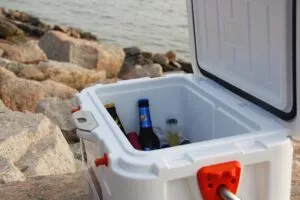
The Best Coolers In Canada
Looking to keep your drinks cold all summer? This cool guide will help you pick the best cooler.

The Best Hiking Boots and Trail Shoes in Canada
Boots and shoes are perhaps the most important piece of gear for any hiker.

The Best Camping Tents in Canada
Camping is one of the best ways to get into nature, but without the perfect tent – your trip can go downhill fast.
